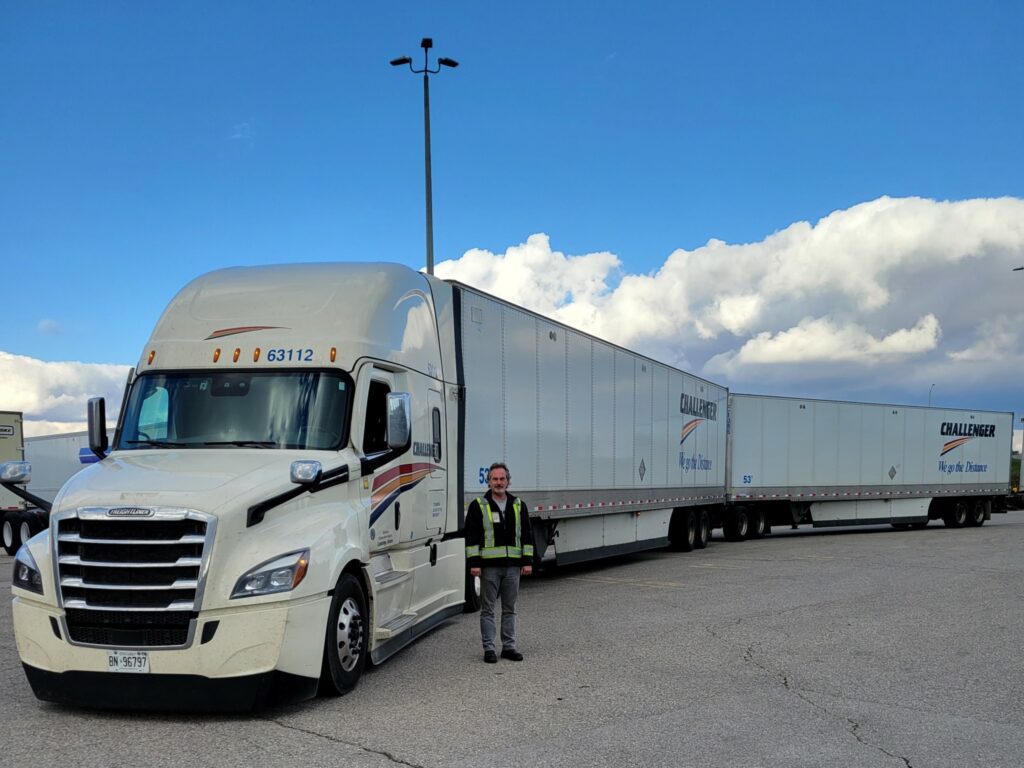Dyksterhuis combines calm attitude, confidence with LCVs
Jeff Dyksterhuis comes across as a calm, confident guy who knows his business.
You’d want a calm, confident guy who knows his business operating a 40-meter-long vehicle that hauls thousands of kilograms of freight down a highway at 90 kilometres an hour.
And that he does. Dyksterhuis drives long combination vehicles (LCVs) – a tractor pulling two full-length trailers – for a living. He takes pride in doing something that is different and takes a little extra thought, too.

The 56-year-old has been a professional driver for 31 years and spent 29 of those pulling loads for Cambridge, Ont.-based Challenger Motor Freight.
“Don’t let people get under your skin.”
Jeff Dyksterhuis, LCV driver, Challenger Motor Freight
“Observe your surroundings and the traffic around you, stay calm, and don’t let people get under your skin. Enjoy the drive. It is something unique and special,” he says of the secrets to success.
As a child, Dyksterhuis bounced around feed trucks with his father, who also drove for Challenger, and went on a few trips with him. “So, I thought I would drive trucks as well,” he says.
At Challenger, Dyksterhuis has mostly run local, hauling stuff a couple of times into Michigan, and some loads into Quebec. But his career took a different turn 13 years ago, when he was asked if he wanted to operate an LCV.
“It was a spur-of-the-moment decision that turned out well. It was a new challenge and I wanted to try something new.”
How to set up an LCV
A typical workday begins in Woodstock, Ont., where Dyksterhuis gathers his load assignments and figures out trailer weights. The heavier trailer always goes in front. He then finds the trailer destined for the back of the LCV, inspects it, hooks on to it, and drives to the staging area where he drops it.
From there, his focus turns to inspecting the dolly that will link the two trailers, picking it up, lining it in front of the back trailer, and dropping it.
After that, he heads to the lead trailer, inspects it, hooks it up, and lines up in front of the dolly. “Then I start hooking them all together,” he says.
For an experienced driver like Dyksterhuis, the process ideally takes about an hour.
Inspecting equipment
His dedicated run to Windsor, Ont., which is about 230 km away, takes about three hours because his speed limit is capped at 90 km/h. He has a mandatory stop along the way where he inspects equipment.
At the final destination he breaks down and parks the trailers he’s hauled, checks his trailers with return loads, hooks them up, and heads back to Woodstock.
He works about 10 hours a day, five days a week. But there are occasional weekend loads when someone is sick or there is extra freight that must be moved.

Driving a large vehicle comes with its challenges, though, especially when it comes to the attitudes of other motorists — including fellow truckers. “People don’t realize how long an LCV is and there is the danger they could drive into the side of the vehicle,” Dyksterhuis says.
Finding parking is difficult at ONroute rest areas, too, especially westbound on Highway 401, as tractor-trailers take up LCV spots, he adds.
Training drivers
Soon he’ll have a chance to share his experience with peers.
Challenger recently asked Dyksterhuis to train new LCV drivers. He admits it will feel “a little weird and different sitting on the wrong side of the truck.” But he is happy with the chance to share his knowledge.
Down the road, he still wants to continue work behind the wheel. “I don’t see myself doing the office side of training. I am not an office person and will not be doing a desk job.”
His dreams simply include something decidedly bigger than a desk.
Have your say
This is a moderated forum. Comments will no longer be published unless they are accompanied by a first and last name and a verifiable email address. (Today's Trucking will not publish or share the email address.) Profane language and content deemed to be libelous, racist, or threatening in nature will not be published under any circumstances.
-
We need better parking and pull offs I have seen these double trailers cause several crashes by others in construction zones
We should have the front trailer limited to 48 feet and a 20 cent / km tax on all double kms to go to improvement in Intersection and parking and a safe place for sick and injured driver housing and medical transport in Ontario in my opinion.
Good for you Jeff….I knew you would always do well and it was a pleasure working with you throughout your career and with your Dad…Congratulations on your continued success.
Best Regards,
Bob Halfyard
There were a few LCV’s traveling East on the 401 towards Eastern Ontario and/or Quebec that appeared to be driving over 90 kph when I ran that corridor or are those trucks monitored for speeds over 90 kph? The industry definitely needs experienced, professionals and patient trainers to train the future professionals that pick up and deliver the goods that people use every day
Great 4 him,I’d try it butt they only run those on the Indiana ,ohio,New York, Massachusetts turnpikes, around me ,
We need these PRO badly, they are the future of our industry. Let’s hope the regulations will facilitate and promote lcv’s utilisation